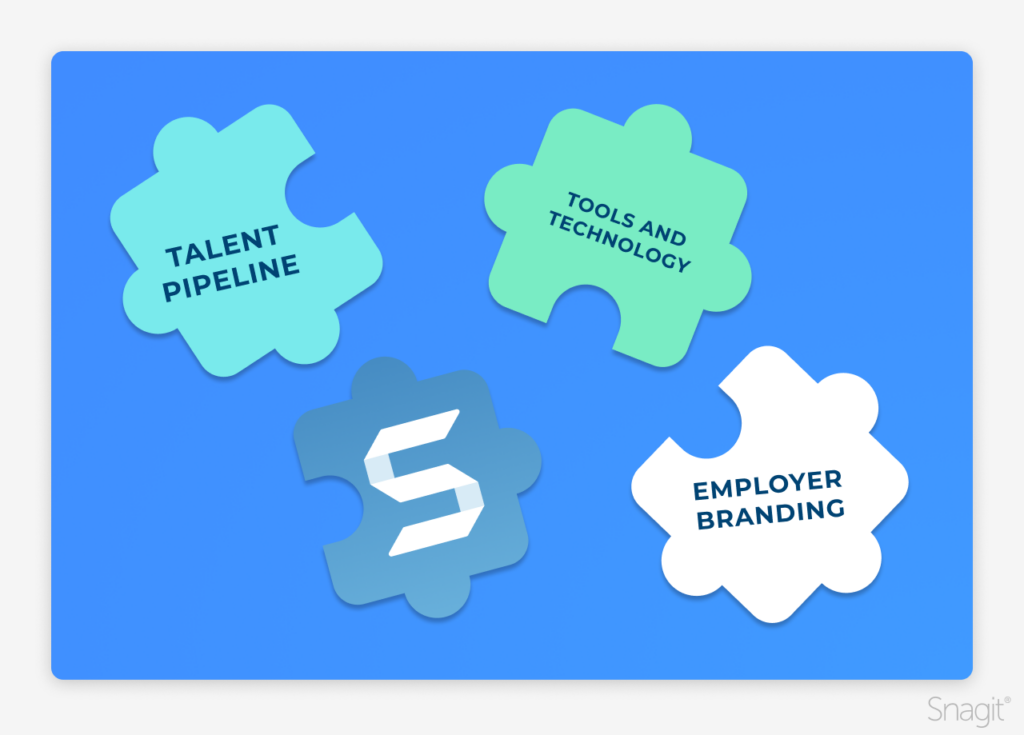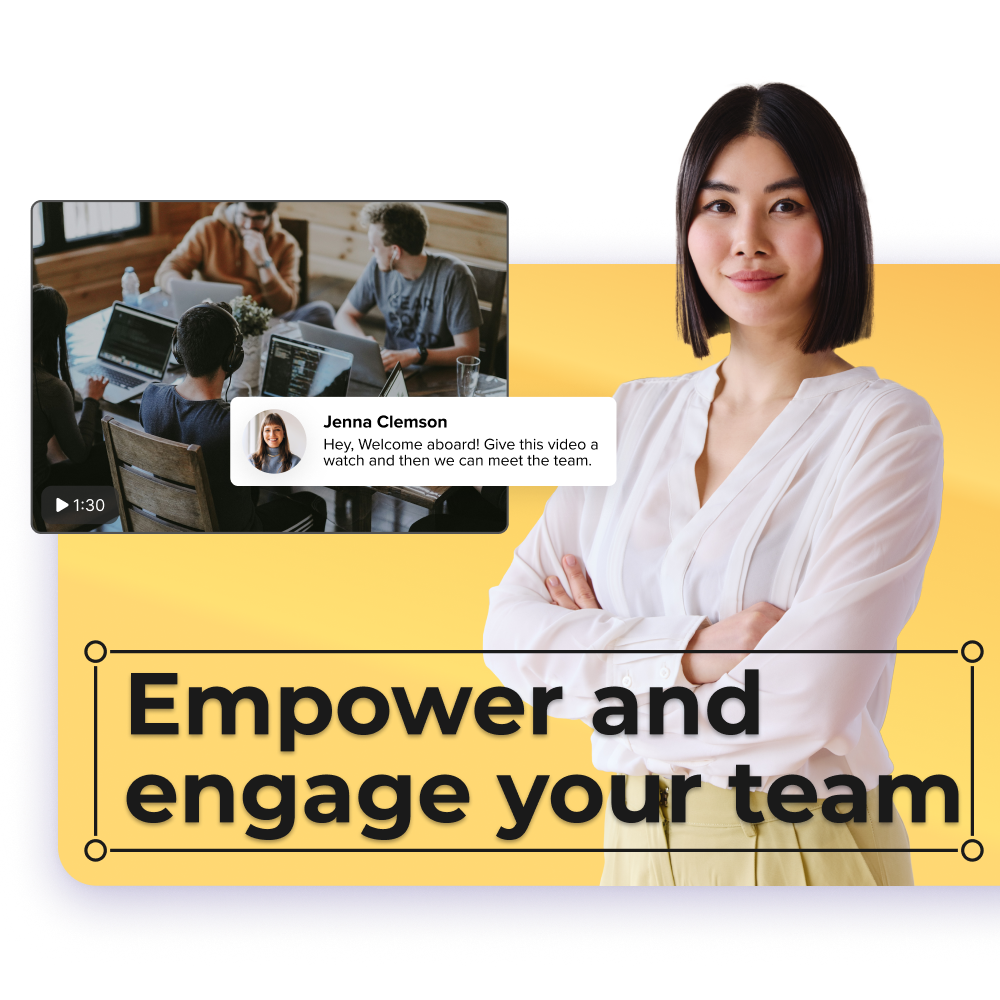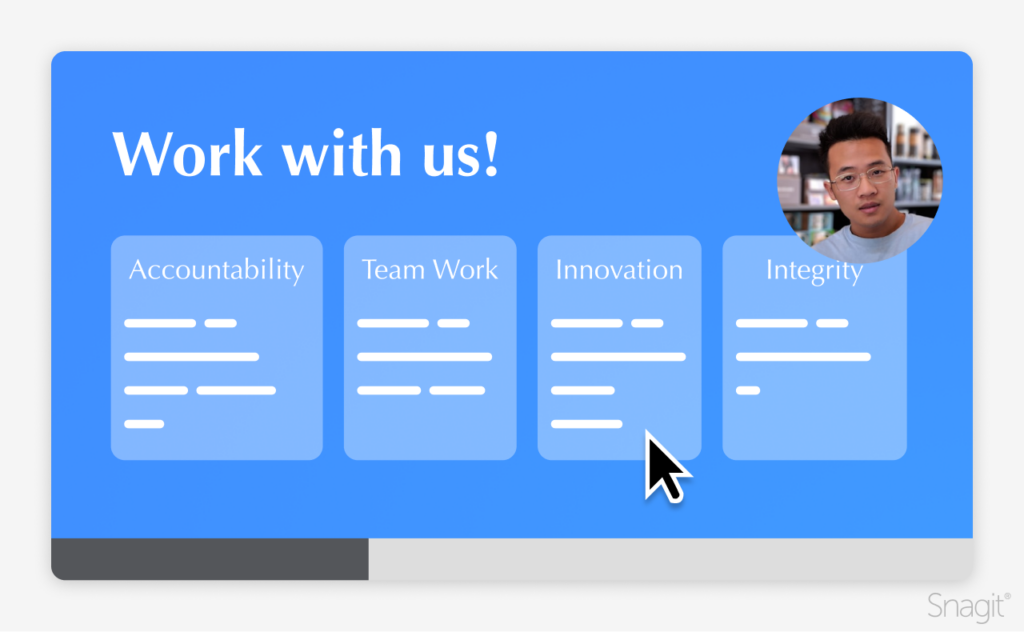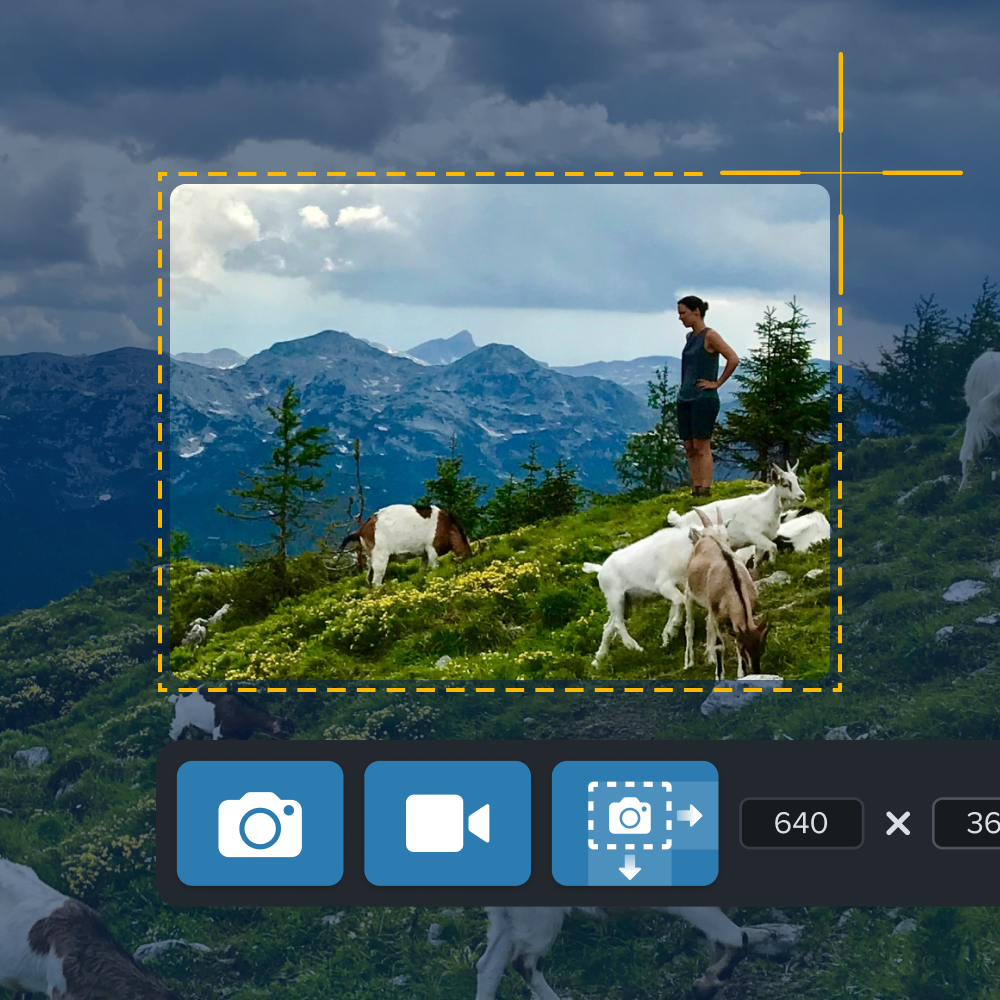When someone leaves your organization, or when your organization is in a state of growth and expansion, how do you get new talent?
If this is the only time you’re thinking about talent, you may be falling short. Reacting to a headcount need of the organization is recruiting. This is where Talent Acquisition differs from recruiting.
Talent acquisition is the process and strategy to identify, attract, consider, and hire top talent. In this article, we’ll break down the different “pieces of the puzzle” that make-up talent acquisition. Additionally, I’ll incorporate some key tools to make it all easier and more impactful, specifically Snagit.

Key strategies for successful talent acquisition
Building a talent pipeline
Remember, we’re not just reacting to immediate needs; our focus is on long-term planning. To build an effective talent pipeline and strengthen your talent acquisition strategy, you first need to understand the current state of talent within your organization.
Ask yourself:
- What is the average tenure in each department?
- What is your turnover rate, and which department has the highest turnover?
- What are the onboarding and training timelines for various roles within the organization?
Once you gather this information, the overall picture becomes clearer.
Find out for your organization: The [insert department name] department has an average turnover rate of [X%] and an average employee tenure of [Y years]. On average, we’re replacing [Z] team members every [quarter/year]. Then, use these numbers to work backward to refine your hiring process and ensure you address the right gaps.
The above information will reveal the biggest gaps in your talent pipeline and help identify your top candidates. Now, go fill in the gaps.
As you look at your talent needs, if you’re an organization that’s losing entry-level talent within the first 90 days (think entry-level, customer-facing roles), then you’ll need a constant flow of candidates. Ultimately, you’re constantly hiring for that role. So, instead of waiting for someone to leave, keep a full talent pool and have someone ready to start at all times.
Conversely, if you have great tenure for a specific role, you can align your talent acquisition to bring people in early in their career (think intern) and train them into an experienced role. Ultimately using less hiring and more training and engagement.
Every organization has its own unique talent acquisition vs. recruitment challenges and needs that will shape your overall strategy. Your organization’s specific situation – whether high turnover in certain roles or long tenures in others–should guide your approach to hiring training and retention.
Before creating your strategy, make sure you have a clear understanding of where, when, how, and why talent is joining, staying, or leaving. By doing this, you can focus your efforts where they’ll make the most impact and avoid wasting time on guesswork.
Simplify HR workflows with visual tools
Create clear, engaging training and documentation that helps your teams better understand company policies and processes.
Learn More
Employer branding
Whether you create your employer branding or not, you have an employer brand. So, you might as well make what you want true regarding how the talent market views your organization and how it aligns with your recruitment and talent acquisition efforts.
Employer branding is what talent “thinks” of your company.
When they hear your company’s name, do they think of good working conditions or bad?
Do they think of good benefits and pay (think BIG tech companies), or are there rumors around town of poor pay and benefits?
Instead of letting people completely form the narrative of how they view your company, help them view it in the light YOU prefer—one that benefits the company and aligns with your job descriptions and the roles you’re recruiting for.
The more work you do with your employer branding, the less work you have to do on the attraction side. For example, do you think the big tech companies have to convince people to work there? Nope.
People WANT to work there. Why? Because their employer brand is so strong. Here is where screen capture, screen recording, and video editing tools can come in.
Leveraging technology and tools
Video is powerful. Technologies like YouTube, Instagram, and TikTok are important means of information for people across all generations. Video is on the rise in every facet. So, let’s tap into that.
You might think, “I don’t know how to do video, and we don’t have a video team.”
You don’t need prior knowledge or a team of professionals—you just need the right tool. That’s where Snagit and Camtasia come in. I am a novice video creator as in, I’m not good at it. However, using user-friendly tools makes creating videos easy.
“Yeah, but how do I incorporate video into talent acquisition and recruitment?”
When you currently share job openings on various platforms, you probably rely on text. Instead, use video.
If you welcome people to the company via email, including a personalized video. And when you show your employer benefits during the interview or offer stage. USE VIDEO.
Benefits are boring and stale—spice it up and highlight the value of your employer benefits by how it has brought value to YOU.
Whether you’re attracting candidates through LinkedIn InMails, cold messages, building your employer brand, networking within your industry or on college campuses, interviewing candidates, or extending offers—video can enhance almost every step of your talent acquisition process.
Additionally, integrating video with talent acquisition software allows you to streamline and personalize your approach, ultimately giving you better engagement from your audience. Your time goes further (impact-wise) when you’re communicating with video. Why Snagit is Essential for Talent Acquisition Teams

Benefit 1: Visual content creation
Talent Acquisition has to think like marketing, not only from creating your employer brand but also how to deploy it. The way to win with an employer branding strategy is by keeping it alive, which means creating content around it.
Most people, especially younger generations, prefer video as their preferred method of content consumption.
Having an employee event at work, capture it with video.
Have a new position open? Have the hiring manager create a quick video about the team and the opportunity. This is where screen recording comes in.
Using video lets people have a window into your company and the company culture.
This will help you attract top talent and qualified candidates.
Top talent can work anywhere; that is a perk of being the best at what you do. By opening a window to your company, your talent pool will be able to accurately assess and feel what it is like to work with your organization.
Record your screen with Snagit
Snagit makes it easy to share quick updates and how-to’s by capturing exactly what’s happening on your screen.
Get Snagit
Benefit 2: Enhancing effective talent acquisition
By using Snagit in your content creation, talent acquisition process, and new hire onboarding and training, you can create a clearer picture of the objectives you’re trying to accomplish.
This is thanks to Snagit’s powerful tools for improving visual communication. Features like annotating workflow documents, highlighting important text, and capturing on-screen tutorials help ensure that information is clear, concise, and easy to understand
Not only does this aid knowledge retention, but it also helps provide reasonable accommodations by presenting information in multiple formats to suit diverse needs.
That’s a win for Human Resources.
Benefit 3: Improved internal and candidate communication
One of the most impactful uses of Snagit is when communicating with hiring managers. Your Talent Acquisition Team will love this.
Traditionally, sharing candidate insights involves lengthy emails, phone calls, or meetings. While valuable, these methods can be time-consuming. Snagit streamlines this process, allowing you to quickly create personalized videos that showcase top candidates, including those from employee referrals. With just a few clicks, you can record and share a video that highlights the value the candidate may bring to your organization.
By leveraging another tool from TechSmith, Screencast, you can track when a hiring manager views your videos, how long they watched, and invite them to place comments at specific points in the video.
This makes the candidate review process more efficient and engaging—no more endless meetings or dry emails. Instead, you’re using video to tell the candidate’s story.
Ready to enhance your talent acquisition efforts with Snagit?
If you’re serious about your talent acquisition business goals and finding top talent, consider changing your recruiting strategies from reactive to proactive. Create an employer brand and keep your brand alive through content creation.
Make video a core piece of your skill sets within talent acquisition. You will have more impact within the business and more impact with your talent pool.
The best snipping tool for Windows and Mac
Don’t let clumsy built-in tools hold you back. Take and edit screenshots with Snagit!
Get Snagit



Share